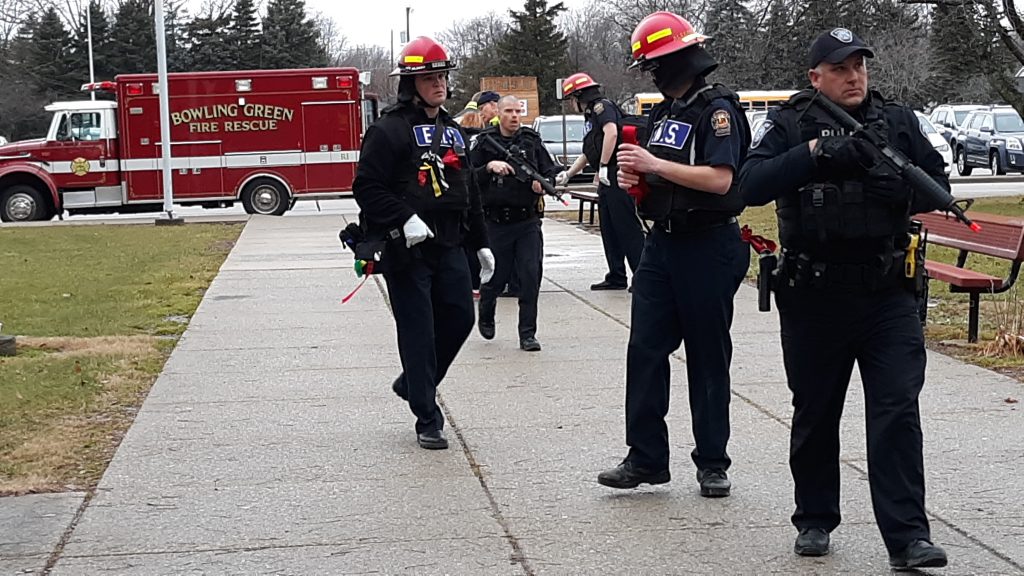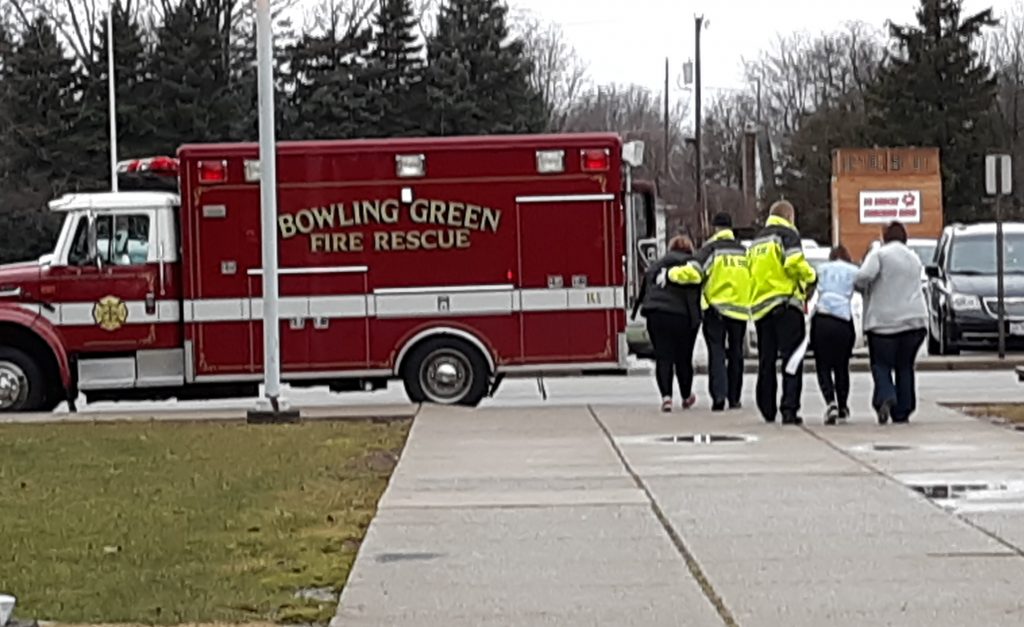By JAN LARSON McLAUGHLIN
BG Independent News
The teachers were told the gunshots would be blanks. They knew the students screaming for help in the hallways were acting. And they had been prepared for the “shooters” trying to barge into their classrooms.
But when the gunfire began, the adrenaline started pumping.
“We could hear the shooting,” said Mary Lou Zweibel, Conneaut music teacher, who was barricaded in a classroom on the second floor of Bowling Green High School on Friday. Occasionally, someone in the classroom would peek out the window on the door to see if the coast was clear.
“We could hear a person crying for help,” Zweibel said. “We decided to stay put.”
Others took their chance running for the door. Science teacher Paula Williams put “the boot” mechanism in the classroom door to keep out intruders. She and others then moved tables to further block the door and covered the windows that could be seen from the glass hallway in the high school.
“When we knew they were on the second floor, we exited through the custodian’s exit,” Williams said.
Williams’ classroom made it out safely, but some drama club students with fake blood stains were strewn across the hallway on the second floor where one of the “gunmen” took a hostage.

The active shooting exercise that took months to plan was over in less than an hour. But those participating learned how time seemed to move agonizingly slowly as they waited to be rescued.
After it was over, one of the teachers asked how long the drill had lasted – it seemed like three hours. It was more like 45 minutes.
“I know it felt like a long time,” Bowling Green Police Officer Robin Short said to district’s entire staff who participated in the exercise held just as winter break was to begin.
The school faculty and staff were not the only ones tested on Friday. This was also a drill for Bowling Green police and fire divisions, who were not told of the scenario details planned by Police Sgt. Mike Bengela.
And it was a chance for 30 drama students to test out their fake blood, try to escape or find hiding places throughout the school.
The scenario went like this: Two shooters entered the high school at 11:07 a.m. They began running through the halls, shouting and shooting blanks.
An announcement went through the school: “Please lock down and boot up,” referring to the metal boot mechanisms that keep intruders from getting into classrooms. To add a little more pressure, some of “the boots” had been removed from the rooms, so staff had to find alternate ways to barricade the doors.
In the office, Assistant Principal Dan Black was able to pull up the hallway camera images of the shooters running through the school. He tried to keep updating their locations on the PA system. That helped some classrooms, where the staff was warned that a shooter was nearby. But one of the shooters caught on and as soon as Black gave his location over the PA, the shooter ran the opposite direction. So some staff trying to escape down the staircase instead encountered the shooter.

Within four minutes, the first police officer was on the scene. And unlike law enforcement responses of the past, he entered the school alone, looking for the shooters.
“We don’t wait for anybody, we just go to take care of the bad guy,” Short said.
After a couple minutes, the police radios crackled with the news that one shooter was down, and that multiple victims were on the second floor. The second shooter was barricaded in the computer lab with a “hostage.”
Meanwhile, bursts of students would run out the building screaming.
As a negotiator talked with the shooter on the phone, special rescue teams continued to search room by room – looking for more victims, more people hiding, or more “bad guys.”
A delay occurred when a “key” could not be located for “the boot” being used by the shooter to barricade himself in with the hostage. That would be one of the lessons learned on Friday.
Another problem identified during the drill was the lack of good ways to communicate with staff – without the shooters being able to intercept the information.

“I thought it was an eye opening experience,” Zweibel said. “It makes you think and reassess your environment. No job is really safe today.”
And that was another of the lessons from Friday’s drill.
“Unfortunately in today’s schools this is one of the things everyone is talking about, everyone is thinking about,” Superintendent Francis Scruci said.
Though the school district has armed the buildings with “the boots,” ballistic shields, and special film over glass, the ALICE training put the focus on the staff.
“Hopefully it never happens here, but we learned a lot today,” Scruci said.
Scruci praised the planning and skill of the city police and fire personnel, who were joined for the drill by officers from Perrysburg, Rossford and Wood County EMA.
Prior to the exercise starting, the staff was given a refresher on the ALICE (Alert, Lockdown, Inform, Counter and Evacuate) system that encourages people to do something – whether that’s fighting back, barricading, or running away.
“You can do more than hide underneath the table and hope for the best,” Bengela said.
“Probably nobody here got into education to be self-defense experts,” he said. “Yes, we do want you to fight back.”
Running, finding some types of makeshift weapon, or pushing tables up against a door are all better than cowering in the open.
“Being passive just makes you an easy target,” Bengela said. “Anything beats doing nothing.”
And when Bengela says run, he means keep running. “Go until you feel safe,” he said.
He suggested that people go online to find out what it sounds like when a shooter is reloading – the precious seconds when it may be safe to make a run for it.
To give the staff an idea of the horror and fear felt during a shooting situation, Bengela showed a video of a re-enactment of the Columbine shooters during their 8 minutes in the school library. The video left many stunned.
“Imagine how intense a real incident would be,” he said.

Law enforcement and EMS have learned a lot since Columbine, when first responders waited for hours before entering the school. Bowling Green police officers are trained to go in as soon as they arrive on the scene.
The local police and fire divisions have trained together to act as a rescue task force, so paramedics can enter the building under police protection to render care to those unable to come out.
“We’re not going to let anyone sit in a bathroom and bleed out for three hours,” Bengela said referring to a teacher who died at Columbine.
Bengela and Short suggested school staff can take steps to be prepared. For example:
- Know all the exits in the school and take different routes in the building so you are familiar with them.
- Learn First Aid. “You are your own first responder to keep yourself alive” until someone can reach you, Bengela said.
- Practice putting “the boots” in the doors until it becomes automatic. “You may have practiced putting that boot in the door 100 times,” but stress makes it much more difficult, Short said.
- Identify items in the classrooms that can be used as weapons against intruders. Anything from a coffee mug to a baseball bat can help. If you are planning to use a desk drawer as a weapon, make sure it can actually be pulled out from the desk.
- Quit leaving doors open that are supposed to be locked, out of convenience.
- Make sure the items you have identified as possible barricades will work that way. “If your plan is to move the file cabinet in front of the door, are you able to move it?” Short asked.
- Check if classroom windows open wide enough for people to escape that way.
- Go back to the classrooms and educate students and ask them to brainstorm about possible defense actions. Have students practice engaging “the boots” and opening the windows.
“We are not going to be sitting ducks,” Bengela said.

